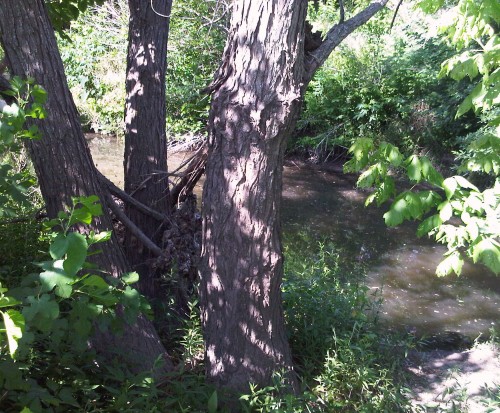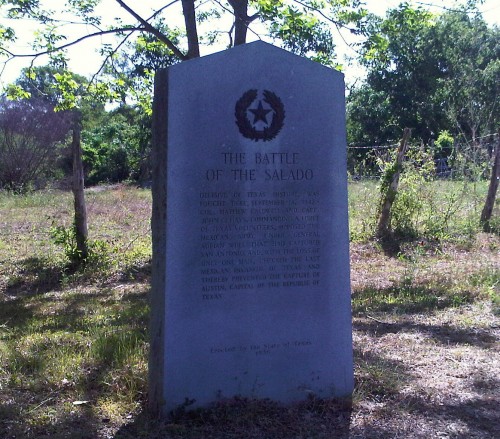Most people accept as conventional wisdom about the Texas frontier, that Anglo settlers were always the consummate horsemen, cowboys and cavalrymen that they were at the height of the cattle boom years. But that was not so: there was a learning curve involved. The wealthier Texas settlers who came from the Southern states of course valued fine horseflesh. Horse-races were always a popular amusement, and the more down-to-earth farmers and tradesmen who came to Texas used horses as draft animals. But the Anglo element was not accustomed to working cattle the long-horned and wilderness adapted descendents of Spanish cattle from horseback. Their eastern cattle were slow, tame and lumbering. Nor were many of them as accustomed to making war from the saddle as the Comanche were. Most of Sam Houston’s army who won victory at San Jacinto, were foot-soldiers: his scouts and cavalry was a comparatively small component of his force. It was a deliberate part of Sam Houston’s strategy to fall back into East Texas, where the lay of the land worked in the favor of his army. The Anglos’ preferred weapon in those early days in Texas the long Kentucky rifle, a muzzle-loading weapon, impossible to use effectively in the saddle, more suited to their preferred cover of woods not the rolling grasslands interspersed with occasional clumps of trees which afforded Mexican lancers such grand maneuvering room.
When did this begin to change for the Anglo-Texans? Always hard to say about such things, but I suspect that the Anglo-Texas began morphing into becoming what they fought almost as soon as Texas declared independence in 1836. The war with the Comanche was unrelenting for fifty years, and conflict with Mexico was open for all of the decade that the Republic of Texas existed, as well as simmering away in fits and starts for even longer. And one of the agents taking an active part in that metamorphosis from settler to centaur was John Coffee “Jack” Hays, during a handful of years that he led a company of Rangers stationed in San Antonio. The Rangers were not lawmen, then they were local companies organized to protect their own communities from depredations by raiding Indians, and as close to cavalry as the perennially broke Republic of Texas possessed. Jack Hays, who with fifteen of his Rangers had narrowly escaped being caught in San Antonio when Woll’s troops took the town was one of the most innovative and aggressive Ranger company captains. He had already begun schooling his contingent in horsemanship and hard riding, and in use of five-shot repeating pistols developed by Samuel Colt. It was Hay’s contingent who spread the alarm, and militia volunteers began to assemble from across the westernmost inhabited part of Anglo-Texas. Colonel Matthew “Old Paint”Caldwell, from Gonzales began gathering a scratch force at Seguin, east and south of San Antonio. He collected up about a hundred and forty, and set out for a camp on Cibolo Creek, twenty miles from San Antonio, before settling on another camp, on the Salado, seven miles north of San Antonio. He gathered another seventy or eighty volunteers and more were on the way. But “Old Paint” was in any case, outnumbered several times over, and being a sensible man knew there was absolutely no chance of re-taking San Antonio in a head-on assault. But what if a sufficient number of Woll’s force could be lured out of the town which may not have been a fortified town in the European sense of things, but certainly was set up to enable a stout defense against lightly-armed infantry. Caldwell arranged his few men efficiently, among the trees, deep thickets and rocky banks of the creek, with the water at their backs, and the rolling prairie, dotted with trees all the way to San Antonio spread out before them. Could any part of Woll’s invaders be lured into a kill-zone? The Texians grimly proposed to find out.
There were only thirty-eight horses counted fit enough for what would be an easy ride to San Antonio, but undoubtedly a hard ride back. Jack Hays and his Rangers, and another dozen men were dispatched very early on the morning of September 17th. At a certain point, still short of San Antonio, Hays ordered twenty-nine of the men with him to dismount and set up an ambush. He and the remaining eight then rode on to within half a mile of the Alamo, where the main part of Woll’s force had camped. They would have been clearly seen from the walls of the old presidio; it would have been about sunrise. What else did they do besides show themselves? Perhaps they fired a few shots into the air, shouted taunts, made obscene gestures clearly visible to anyone with a spyglass. It was their assignment to provoke at least fifty of Woll’s cavalrymen into chasing after them, hell for leather . . . instead, two hundred Mexican cavalrymen boiled out of the Alamo, along with forty Cherokee Indians (who at that time had allied themselves with Mexico) and another three hundred and more, led personally by General Woll. Hay’s provocation had worked a little too well it was a running fight, all the seven miles back to the camp and the carefully arranged line of Texians with the Salado and the green forest of the trees and thickets at their back. Caldwell and the others were just eating breakfast when Hays and his party arrived breathlessly and at a full gallop. Over two hundred shots had been fired at them, none with any effect not particularly surprising, given that it would have been extremely difficult to hit a moving target from a position on a galloping horse, and that reloading would have been near to impossible.

(The banks of Salado Creek today)
Having succeeded beyond their wildest dreams in drawing the Mexican force to follow them, Jack Hays and the others took up their position in “Old Paint” Caldwell’s line carefully screened and sheltered among the trees. Caldwell sent out messages saying that he was surrounded, but in a good spot for defense, if any at all could come to his aid and so it turned out to be. The canny old Indian-fighter had a good eye for the ground, and for an enemy. The pursuing Mexican cavalry drew up short, upon seeing his positions, or whatever evidence they could see from their position on the open prairie, looking into the trees along the Salado but they did not withdraw entirely. Instead, Woll, and most of his command lined up and prepared to sling a great deal of musket-fire and a barrage of artillery shot in the direction of Caldwell’s force, none of which had any noticeable effect at all on the Texians. Instead, Anglo-Texian skirmishers went forward with their chosen and familiar weapon and from their favorite cover sniped at leisure all through the next five hours, inflicting considerable casualties, before scampering back to safety on the creek-bank. Some sources claim at least sixty dead and twice that number wounded, against one Texian killed, nine or ten injured and another half-dozen having had hairbreadth escapes. At one point, General Woll ordered a direct attack a few of his soldiers got within twenty feet of the dug-in Texians. Being a fairly rational man, and a professional soldier, the General knew when it was time to cut his losses. Leaving his campfires burning, he and his forces silently fell back to San Antonio under the cover of night, and then withdrew even farther all the way back towards the Rio Grande.
This would have been a complete and total victory for Caldwell . . . except for one unfortunate circumstance: a company of fifty or so volunteers from Bastrop, on their way to join him, had the misfortune to almost make it to even hear the sounds of the fight, from two miles distant. The company of Captain Nicholas Mosby Dawson, from Bastrop and the upper Colorado was caught by Woll’s rear-guard, as they retreated. Only fifteen of Dawson’s men would survive that battle and surrender to superior military force. Caldwell’s men would find the bodies of the dead on the following day, as the pursued Woll towards the somewhat amorphous border. The fifteen Dawson men would join those Anglo-Texians taken prisoner in San Antonio in chains in Perote prison some of those would be held in durance vile until early 1844.

Quite a story! Audaciousness in battle can sometimes bring huge rewards – if they don’t wipe you out ;-)
Do you think anyone – Comanche included – could shoot accurately from a galloping horse? Aside from John Wayne and Tom Mix?
The story of those early Texas Rangers is quite a story – Think of those guys out on the plains with minimal supplies – little/no water ….
Shooting from the back of a galloping horse? Only at point-blank range, I think.
The exploits of the early Rangers was pretty incredible. What I didn’t realize when I started the research for Deep in the Heart was how intense the border ‘cold war’ was with Mexico. There were raids by Mexican Army detachments and plain old bandits deep into Texas, and Mexican agents inciting the Indians agains the Texians. Woll’s raid also resulted in the capture of about 50 Anglo-Texians in San Antonio – civilians who were there for the meeting of the district court. They were taken back to Mexico and kept in Perote Prison; most of them for up to two years. Santa Anna went back on the peace treaty he signed after capture almost at once. No wonder that he was hated so intensely.
The other result of all this was that relations between the Anglos and Tejanos were poisoned horribly, as now all Tejanos were suspected of working against the interests of Texas – even patriots like Juan Sequin.
Texas does have quite a history and I too was surprised that the amount of incursion after San Jacinto – traditional “history” teachers teach that after San Jacinto – that was it. Until I start reading your write ups that was my opinion too (hadn’t heard anything else)
There’s a friend in my car club from Waco who loaned me this book on the old Texas Rangers – one of them was instrumental in getting the Panama Canal get built – the jungle was infested with bandits – and this one retired Ranger was hired to clean things up.
He studied the situation for a few months – then one month – he and the locals he hired – hung nearly every bandit -in several towns – all in one night.